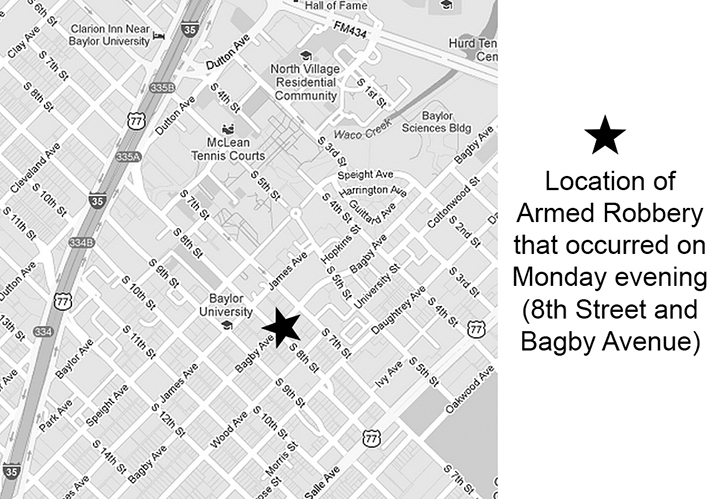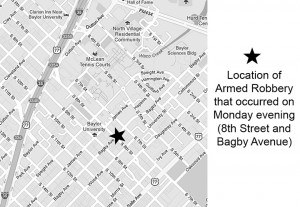

Photo Illustration by Matt Hellman | Lariat Photo Editor
By Caroline Brewton
City editor
Following an armed robbery that occurred near campus Monday night, Baylor students, faculty and staff received emergency alerts that have led to the refinement of Baylor’s emergency notification system.
The notices, which were sent at 11:18 p.m. by Leigh Ann Moffett of Baylor Emergency Management, alerted readers to an incident that occurred near the intersection of Eighth Street and Bagby Avenue.
The email said an armed suspect, a black man approximately 5 feet 4 inches tall and wearing a blue-and-white lettered jacket, approached a female victim with a handgun.
Those subscribed to the Baylor Emergency Alert text message system also received a text message warning them of an armed suspect seen running west on Bagby Avenue following the incident and instructing them to check their email for more information.
The alerts identified a female victim, but Waco Police Sgt. W. Patrick Swanton said the victim was a 26-year-old Asian male.
A routine review of the alerts done on Tuesday has led Baylor PD and Media Communications to re-evaluate the emergency procedures in place.
Swanton said the robbery took place about 9:30 p.m. Monday night in the alleyway behind University Plaza Apartments, located in the 1700 block of South Eighth Street. The victim was robbed at gunpoint for his cellphone, car keys and wallet. During the course of the robbery, the suspect assaulted the victim and the suspect’s handgun discharged, although no gunshot injuries related to the crime have been reported.
Prior to the robbery, the victim was walking in the alleyway and talking with an Asian female. Swanton said the police don’t currently view the female as a suspect or a victim, and her role in the incident is unclear.
After the female left, the victim was approached by the suspect, who showed a handgun and robbed the victim.
The suspect was last seen running down the alleyway where the robbery took place. The suspect is a black male in his early 20s; this was reported correctly in the Baylor alerts. He weighed approximately 140 pounds, Swanton said.
At this time, it is unclear whether any of the people involved in the robbery are connected to Baylor University.
Moffett said the notices were sent roughly an hour and 48 minutes after the event. Moffett herself sent the notices but declined to comment on why the notices were sent so long after the event.
Director of media communications Lori Fogleman said the time lapse between the event and the sending of the message was due in part to the time it took police at the scene to determine what had occurred during the incident.
Once the Baylor Police Department had received some credible information, they discussed sending a warning with university officials and the university decided to send the warning, Fogleman said.
“Any time there is an incident that involves a handgun and it is near our campus, we are going to err on the side of caution and notify our faculty, staff and students about it,” she said. The error in the identification of the victim was the result of an error in communication, she said.
Fogleman said the university conducts post-incident reviews of warnings as standard procedure, to ensure the procedures “don’t impede how quickly and accurately we can respond.” The post-incident review of Monday night’s warning has led to the training of additional personnel at the Baylor Police Department in the use of the emergency notification system and other changes to free up the direct line of communication between the Baylor PD and Baylor Media Communications.
“We appreciate those who very thoughtfully communicated their concerns about the message sent out last night,” Fogleman said. “We can always improve, and we continue to refine our procedures so we can communicate as quickly and as accurately as we can in the event of an emergency.”
Moffett said all Baylor email addresses received the email message, but that only those subscribed to the emergency alert texts received the text message.
Students may provide a cell phone number or opt out of the notifications by visiting Bearweb. According to the Baylor website, Bearweb data is uploaded once weekly to the emergency notification system.
Those who provide a cell phone number to the university without opting out of the notifications in Bearweb will automatically receive the notifications.
Fogleman said the incident served as an opportunity to remind students of safety procedures: to be alert to their surroundings, and to ensure their emergency contact information is complete and up-to-date in Bearweb.





